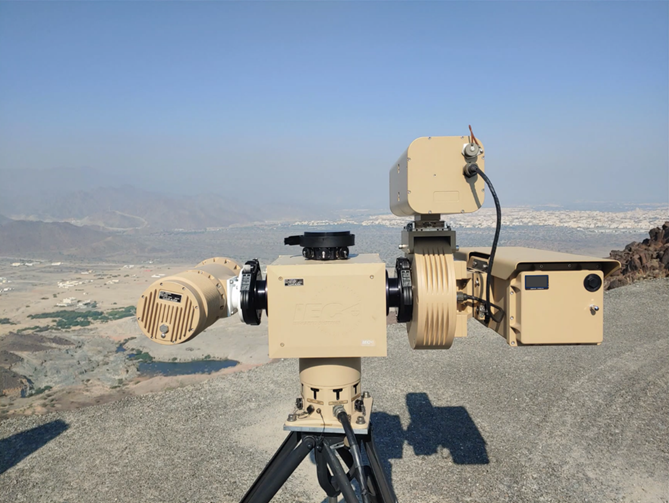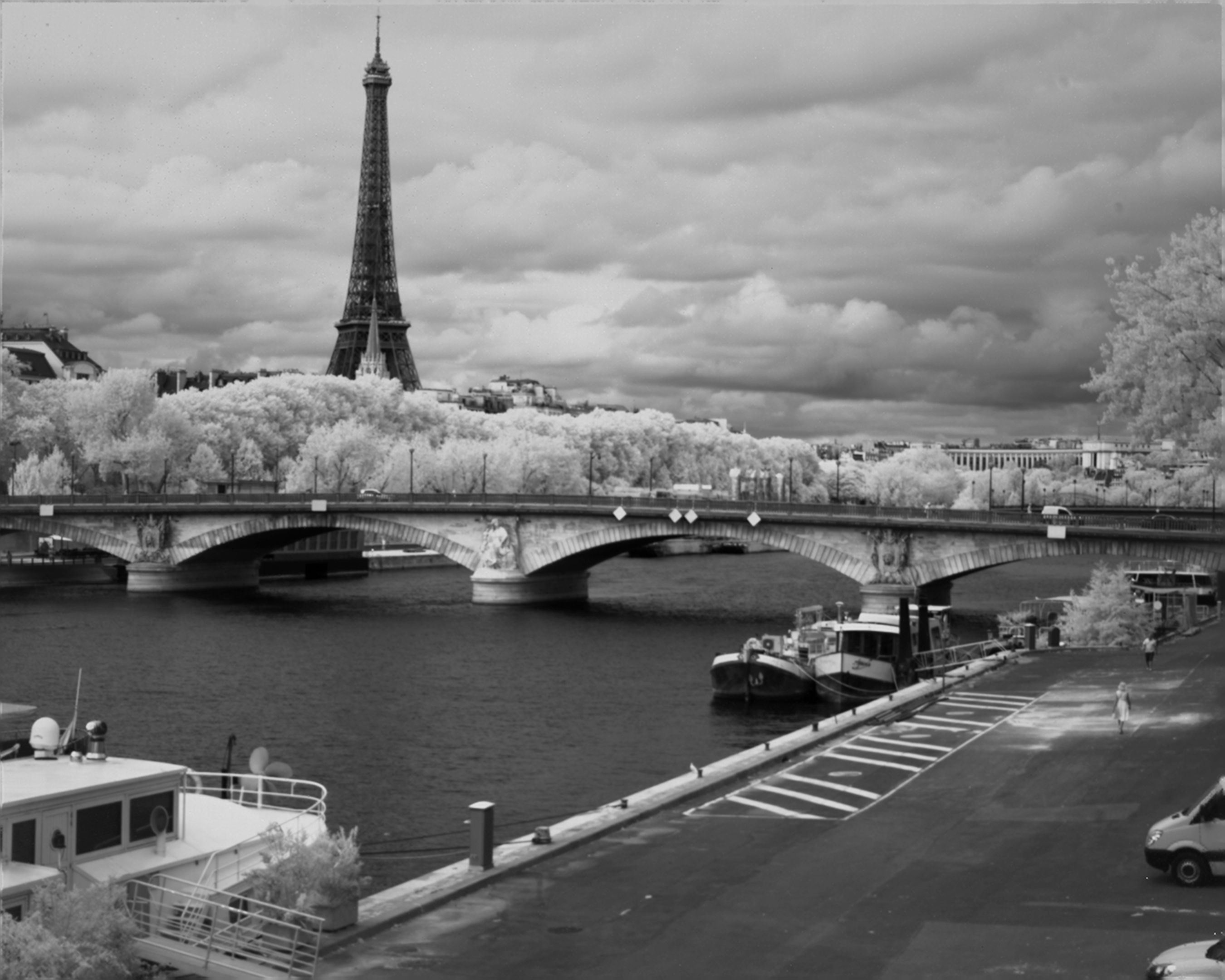What is SWIR?
SWIR is ideal for low light and seeeing through smoke, fog and haze. Short wave infrared (SWIR), encompasses the segment of the electromagnetic spectrum positioned between the visible and thermal infrared wavebands. The typical SWIR wavelength range is nominally 0.9 µm to 1.7 µm.
Although invisible to the human eye, SWIR wavelengths can be detected with high performance sensors, such as Indium Gallium Arsenide (InGaAs). The typical SWIR range can also be broadened so SWIR sensors can have sensitivity to wavelengths beyond 2.5 µm and also increased sensitivity in the visible. The recent development of eSWIR and VIS-SWIR sensors further increases the number of applications that short wave infrared can address.

Unlike the thermal infrared wavebands (MWIR & LWIR), SWIR detects reflected radiation rather than thermal emission, in this respect, it is more similar to visible spectrum, which requires a source of illumination. The natural illumination source for visible radiation is the sun, for NIR and SWIR it is the moon, stars, and ‘nightglow’ - a light emanating from the night sky.
SWIR is not a Night Vision Technology
Due to its sensitivity to night-time illumination, SWIR has often been considered a form of digital Night Vision, utilizing the night sky illumination. Whilst this is possible in some conditions there are compromises due to the need for the sensor to gather sufficient illumination to produce acceptable image quality. During the night, the number of photons available is of the order of just a few tens at a 60 Hz frame rate. The requirement for higher level sensitivity drives larger pixels, which has an adverse impact on system resolution.

Applications for SWIR Imaging
Shortwave Infrared Range Advantages for Border Surveillance
Border Surveillance requires 24/7, high-resolution imaging to detect and identify illegal activity at ranges of tens of kilometers. These distances demand the highest resolution thermal imaging cameras to provide the requisite level of fidelity. Until recently, SWIR sensor technology had not offered sufficient benefits for Border Surveillance, predominantly due to lower resolution sensor formats. New advancements creating higher resolution sensors now make SWIR cameras well suited to high definition surveillance.
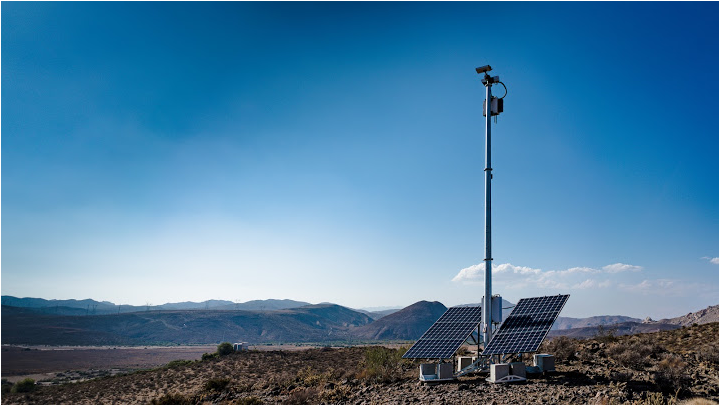
For Maritime and Coastal Applications, SWIR Imaging Provides Superior Fog Penetration Compared to Visible Light Imaging
The ability of SWIR cameras to penetrate fog is a key motivation for the advancement of SWIR sensors and makes it ideal for coastal and maritime applications. The imagery below demonstrates the clear advantage that SWIR wavelengths bring in these conditions.
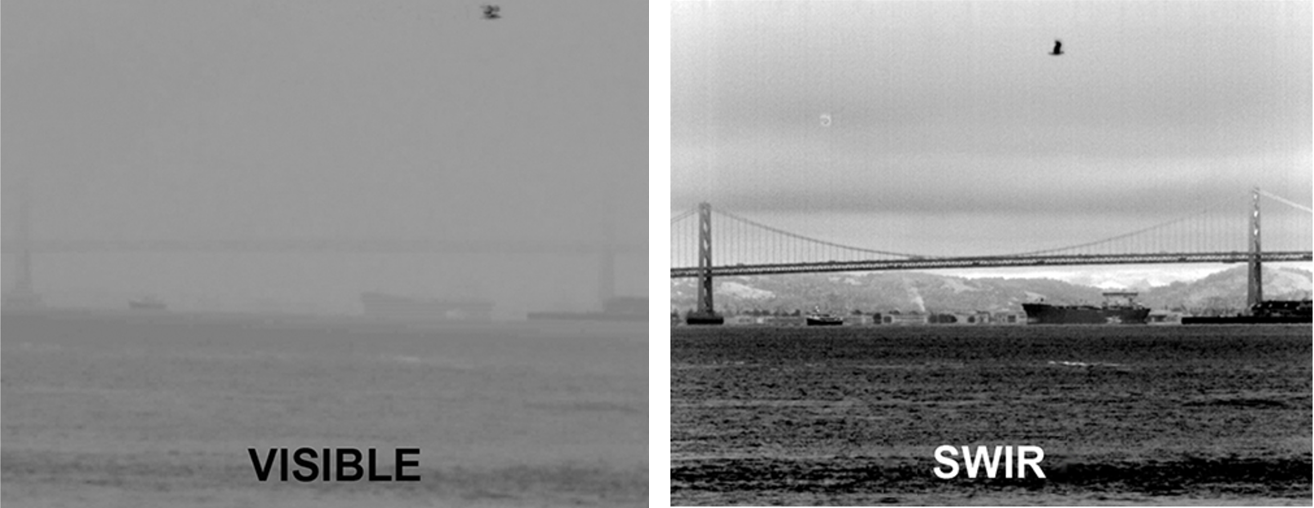
SWIR is Ideal for Industrial Inspection, Agricultural & Food Sorting
Short wave infrared imaging is widely used for machine vision and inspection applications due to the ability of InGaAs sensors to penetrate deeper than visible light for many applications. SWIR is also commonly used in food inspection to identify and segregate fruit with imperfections not visible to the unaided eye.

SWIR Ensures Safe Landing of Commercial Aircraft
Another application of SWIR imaging is for the Enhanced Vision System (EVS) for commercial aircraft. Aircraft use SWIR imaging to help pilots see through fog and clouds on approach to the runway for safe landings.

Laser Detection Using SWIR Sensors
Because SWIR is sensitive to radiation between 0.9 and 1.7 µm, or even more, it is an excellent solution for detecting lasers. Many SWIR sensor ROIC's offer Asynchronous Laser Pulse Detection (ALPD) where short laser pulses can be detected and decoded so the laser threat can be identified and contextually displayed on the image. This capability is implemented on the newest generation of InGaAs sensors.
Medical Imaging using SWIR cameras
In the realm of biological research, SWIR light is advantageous to penetrate deep into biological tissues, surpassing the limitations of visible light. Biomedical researchers leverage this to investigate the structure of various tissue layers situated just beneath the skin, within retinal layers, or along the walls of blood vessels.
Short wave infrared is used for Optical Coherence Tomography (OCT), a technique that gathers image data from different tissue depths. SWIR cameras are also used for early breast cancer detection as well as applications in dentistry evaluating gum disease.
Selecting the Ideal SWIR Sensor Technology
The following table summarizes some of the currently available SWIR sensors. Until recently, SWIR focal plane arrays were limited to VGA formats with 15 µm pixel pitch. Recent technological advancements now enable larger formats with reduced pixel pitch to be realized enabling HD SWIR imaging and beyond.

InGaAs and QCD sensors are not typically cooled, and operate at ambient temperature. MCT and T2SL sensors are the same category of materials used for MWIR imaging but are optimized for the SWIR/eSWIR waveband; MCT and T2SL sensors require cryogenic cooling to around 150k that adds cost.
Examining Figure 3 we can see that the sensor readout noise generally increases as the pixel pitch reduces. For applications operating in photon starved environments, larger pixels may be required. For applications with higher levels of illumination, smaller pixels offer increased resolution and may be the optimum solution. The sensor choice will very much depend on the application.
Scattering of Light in the Atmosphere - SWIR Camera Benefits
Electromagnetic radiation (‘light’) is scattered according to the size of particles suspended in the atmosphere. Longer wavelengths are scattered less than shorter wavelengths depending on the wavelength compared to the particle size. Typical atmospheric particles sizes are listed below.
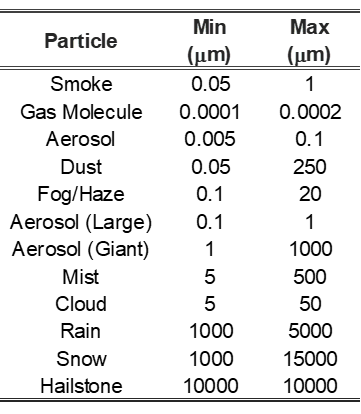
Phenomenologically, we can compare the wavelength with the particle sizes listed in Figure 4 and understand that visible light (0.55 µm) will be affected by fog, haze, mist and low cloud more than longer wavelengths.
We can take a more quantifiable approach by calculating the particle ‘Size Parameter’, x. The Particle size parameter is defined as:

Here r is the radius of the particle, and l is the wavelength of light.
By calculating the size parameter, we can determine if scattering is significant for a given wavelength. Mie scattering (scattering from spheres) occurs for values of x between 0.2 and 2000. If we plot the relationship between particle size and particle size parameter (scatter) we see the relative impact of atmospheric particles for each wavelength. It is clear that the thermal infrared wavebands (LWIR and MWIR) are not significantly impacted by scattering by fog, mist and cloud, but do suffer from water vapor absorption. SWIR wavelengths are also less affected by scattering of these particles and is not absorbed as strongly by humidity. This property of SWIR makes it of interest for Surveillance applications.
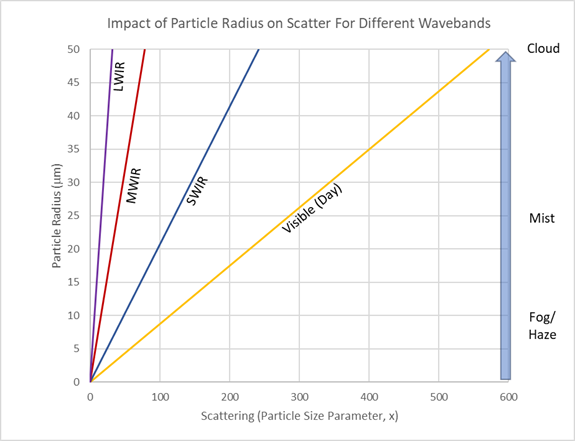
Atmospheric Absorption for Visible, SWIR and Infrared
If we consider the atmospheric absorption for hazy conditions including the effects of aerosol scattering we can compare the effects of different wavebands in the electromagnetic spectrum. The visible waveband suffers from significant attenuation compared to the other wavebands. LWIR is more adversely affected by water vapor absorption, whereas MWIR is less affected to a lesser extent.
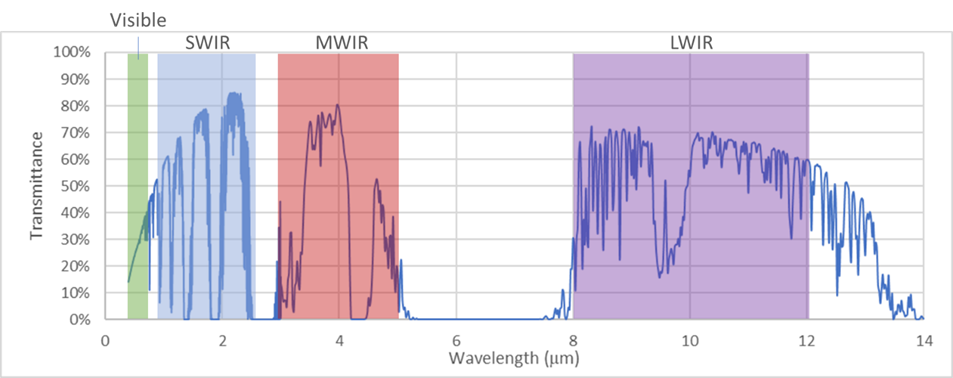
If we inspect the SWIR spectrum in more detail we can see that there are several sub-bands due to molecular absorption. For some applications, filters may be beneficial to optimize transmission for a given task.

Effect of Obscurants on Visible, SWIR, Infrared and Radar
Sanders-Reed et. al. discussed the effects of various obscurants for different waveband ranges including radar. Figure 8 shows the relative visibility for different atmospheric conditions and different levels of rain and fog. This illustrates the visibility improvement of SWIR over the Visible spectrum and the thermal infrared wavebands in humid atmospheres. It also demonstrates the benefit of radar for rain and dense fog over the optical wavebands.
For 24/7 surveillance in all weather conditions, multiple wavebands of the electromagnetic spectrum are a necessary. The specific wavebands required will depend on the exact requirement and location.

Optimized Visible, SWIR & MWIR Surveillance Solutions
High-end surveillance systems include mid wave infrared cameras with resolutions of 30 - 60 c/mR, and day cameras with resolutions of 50-100 c/mR. Building a high-performance system that includes shortwave infrared requires matching your SWIR camera channel to both your MWIR and day channels for optimum performance.
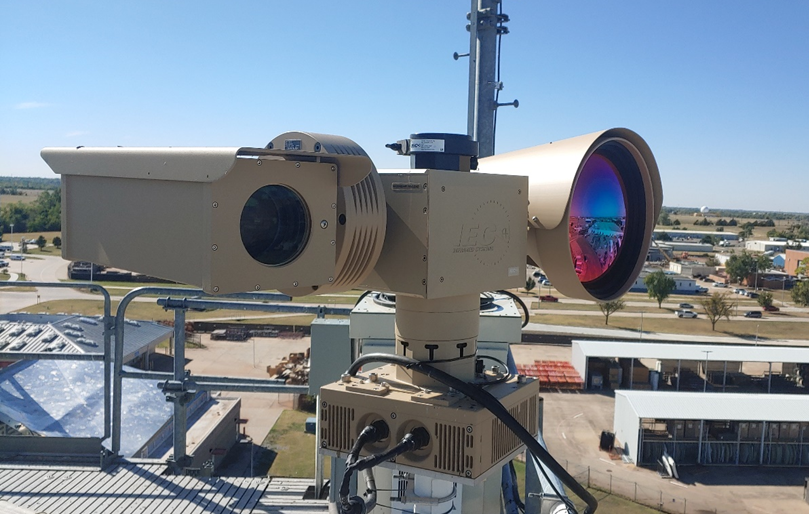
Example options for a SWIR camera are illustrated below in Figure 9. This table shows how smaller pixel pitches offer the opportunity for increased resolution, but are limited in aperture so collect less light. There is a complex trade between pixel pitch, lens F-number and illumination level for a given requirement. Smaller pixel pitch sensors need a faster lens to capture sufficient irradiance to perform at the highest level.
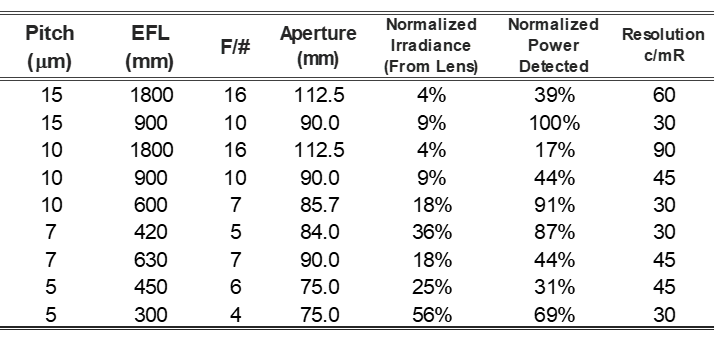
SWIR and MWIR Advantage in Haze
Below we demonstrate an HD MWIR camera and a SD SWIR camera imaging through haze looking at a scene greater than 15 km away. Both MWIR and SWIR wavebands image clearly through haze.

When you compare visible cameras, the benefit of using the thermal and short wave infrared is clear. The visible light is scattered by the haze, while the MWIR and SWIR Cameras are not impacted.

Clear Align Integrated Surveillance Systems - the Choice for the US Capital Region
Clear Align boasts over two decades of expertise in building the most advanced surveillance systems for Border surveillance, Maritime, and Force protection. Our track record includes the US Capital Region, and we proudly stand as the largest camera systems supplier to US Customs and Border Protection. Our partnership boasts:
-
longer-range systems
-
more advanced image processing at the edge
-
modular open systems architecture
-
full tracking capability
-
over 20 years of proven reliability
We look forward to supporting your next project.
